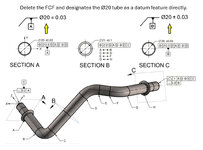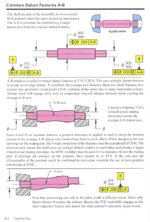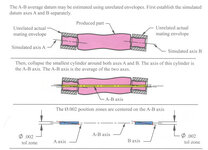RMB is what is being implemented when MMB is ignored. On the drawing, it is indicated by not using the circled M or L modifier following the datum reference letter in the feature control frame. As you know datum features are where you hold the parts at inspection and the holding devices are the "datum feature simulators" that are used to establish the measurement origin.
Inspecting at RMB basically means for a machinist inspecting his own work, or for an inspector, that they are supposed to use an adjustable-size device such as a chuck, a mandrel, a collet, a v-block (which is not really "adjustable" but can support a variety of diameters), or a vise for widths, as the "datum feature simulators". It means that at RMB the part is held firmly at inspection and it means a more stringent check. Because unlike in MMB (MMB uses fixed size devices to simulate the datums), you don't have any play available between the part and the fixture when inspecting features. MMB is more forgiving because for example, if you are inspecting a hole that deviated from its true position quite a bit, you can move the part a little relative to the fixture simulating the datums to make that hole pass. You don't have that with RMB.
That's why the GD&T author you mentioned said MMB can sometimes be ignored. You won't have any out of spec parts passing when implementing RMB even if the specification is at MMB. However if the RMB inspection rejects a part, an MMB check could possibly save it from scrapping.
CMMs are known (or at least used to be known) to have difficulties with reproducing the "play" effect of MMB. So CMM operators could sometimes ignore the MMB and then the inspection is a bit over-restricting, but it is on the safe side as to not having any bad parts pass. For manual inspection, MMB (and MMC) is often very convenient and provide the extra variation that is allowed per design.
yes I under stand that. but it requires a functional gage or CMM. MMB.
whIle that sounds straight cut
and straight forward. actual hardware has complex issues. on simple hardware like a washer is yes very simple. simple truth is
there surfaces that have to be machine precise for tooling. while it can beI some times simple on complex parts.
a straight forward high production cnc turn and milled part with no heat treat , or post heat treat, coating, or dimensions have to be held . with mmb.
an example would be parts that require case hardening on gear teeth, minor diameter, major diameter. teeth profiles. I have to hold final hardness on these surface 60 HRc or micro harness equivalent.
while machining these attributes all can be held precisely. .0015 inch runout, ttce, tce,
profile tolerance. .0005 inch max.
no issues. before heat treat.
Precision ground ring gears are a PITA to
hold roundness. after heat treat. special tooling has to designed developed to maintain roundness while case hardening.
at high temperature.
if the the roundness is not held .007 inch
or less, the parts are scrap.
then afterward post heat treat the ring gears
the faces have to be surface ground flat for toolng within .0005 flatness.
have to be ID grind for tooling. held within .0005 tolerance on the inside diameter.
then an arbor has to be designed and fabricated. ring gears are mounted on the arbor , then the od is precisely ground.
all for tooling. then pot fixture has ti be design and fabricated. ring gear is installed
this fixture for final gear grind.
MMB here is useless.
the reason is if the teeth don't clean up
properly. or grind the teeth case under spec.
scrap.
this is only one example.
these are high risk parts. and have
high scrap rate. but it has to be quoted in.
if a house tries to fabricate these parts.
with out experience expect a 75% scrap rate.
and nothing in ASME will help them.




